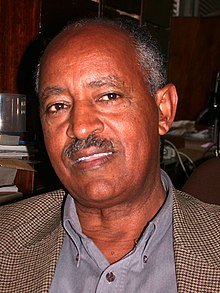Berhane Asfaw
| Berhane Asfaw | |
|---|---|
 |
|
| Born | 22 August 1954 Gondar, Ethiopia |
| Residence | Addis Ababa, Ethiopia |
| Nationality | Ethiopian |
| Alma mater | University of California Berkeley |
| Occupation | Archaeologist and Paleontologist |
| Years active | 1981-present |
Berhane Asfaw (Amharic: በርሃነ አስፋው) (born August 22, 1954 in Gondar, Ethiopia) is an Ethiopian paleontologist of Rift Valley Research Service, who co-discovered human skeletal remains at Herto Bouri, Ethiopia that revealed a transition into modern humans (Homo sapiens sapiens). The specimen was called Homo sapiens idaltu (elder).
He graduated from Addis Ababa University in 1980 and the University of California at Berkeley in 1989.
Berhane's father was the secretary general of Gondar and Berhane has five brothers and eight sisters. Berhane grew up in the Kebele Hulet neighborhood in Gondar. He spent his free time riding a bike and playing football. His parents encouraged him to go to school and Berhane excelled in his studies.
Berhane has been working for the past 25 years as a private researcher at the Ethiopian Ministry of Culture, Centre for Research and Conservation of Cultural Heritage. He established the first research laboratory at the National Museum of Ethiopia. Berhane spearheaded major archeological expeditions into Afar region that led to the ground breaking discoveries in human evolution. In 1981 he co-founded the Middle Awash Research Group. He faced considerable challenges during the Derg period when many of his colleagues were arrested and killed. In addition, Berhane was critical of the Derg's disregard of archeological sites when the Melka Wakena Dam was built in 1988 on a precious open archeological site. In 1992, his group discovered the earliest Acheulean in which the results were the cover feature in Nature. He credits this major discovery in part to the EPRDF bringing stability to Ethiopia thus allowing the research group to work in remote areas. The next major discovery was in 1997, when his group discovered Australopithecus Garh. Over the years his excavations continued to find Australopithecus Anamensis and Homo Erectus as well as discovering five new species making Ethiopia the richest site of early human ancestry; "cradle of mankind".
...
Wikipedia
